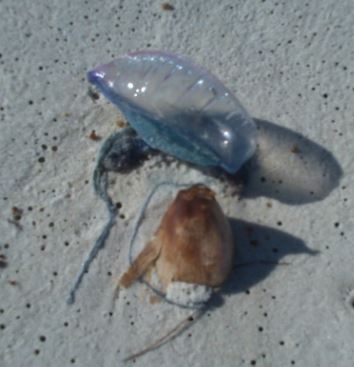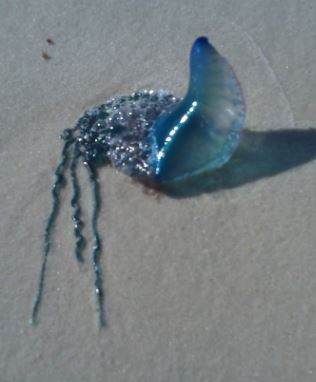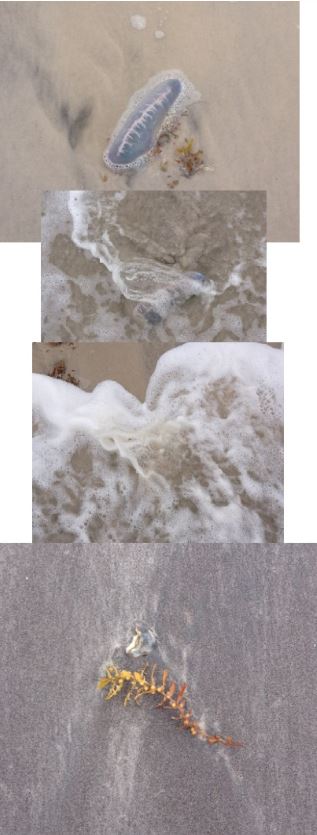 At first it looked like a plastic bag tinged blue. As I got closer I could see a mass of blue-green strands gathered up underneath it like wet yarn. One thread, faintly dotted, stretched over the sand. It was a Portuguese man-o-war stranded by the outgoing tide. Up and down the beach there were more of them, some as big as six or seven inches, others tiny enough that I might have stepped on them if I hadn’t been looking. I’ve read that people sometimes do step on the “sails”, the air-filled sacs that keep the Portuguese man-o-war afloat, to hear them pop. You have to be careful, though. Even when they’re dead the tentacles can still sting for several days. It’s an automatic reaction. Put your foot in the
At first it looked like a plastic bag tinged blue. As I got closer I could see a mass of blue-green strands gathered up underneath it like wet yarn. One thread, faintly dotted, stretched over the sand. It was a Portuguese man-o-war stranded by the outgoing tide. Up and down the beach there were more of them, some as big as six or seven inches, others tiny enough that I might have stepped on them if I hadn’t been looking. I’ve read that people sometimes do step on the “sails”, the air-filled sacs that keep the Portuguese man-o-war afloat, to hear them pop. You have to be careful, though. Even when they’re dead the tentacles can still sting for several days. It’s an automatic reaction. Put your foot in the  wrong place and you’ll be in excruciating pain and have red welts. You can also get a fever, go into shock, and have trouble breathing and heart problems. And, by the way, being urinated on is not an effective treatment, although I’d be tempted to urinate on someone stupid enough to go stomping on an animal on the beach.
wrong place and you’ll be in excruciating pain and have red welts. You can also get a fever, go into shock, and have trouble breathing and heart problems. And, by the way, being urinated on is not an effective treatment, although I’d be tempted to urinate on someone stupid enough to go stomping on an animal on the beach.
 I’m not sure why they’re called a Portuguese man-o-war. Supposedly they look like that particular type of ship, but I wonder if the name isn’t also a joke suggesting that the Portuguese were terrible sailors and could only float where the wind took them. Then again if it were a joke I think Belgian man-o-war would have been a better name. Maybe it’s a compliment to the Portuguese, since a Portuguese man-o-war can still sting you long after the animal itself has died. It’s a purely autonomic response. Maybe Portuguese sailors were just as deadly on land as they were on water. The Portuguese man-o-war’s scientific name is Physalia physalis, so for the rest of this piece I’m going to call them physalians, which I think is a strange and attractive name for a strange and attractive animal. It comes from the Greek word for “bubble”.
I’m not sure why they’re called a Portuguese man-o-war. Supposedly they look like that particular type of ship, but I wonder if the name isn’t also a joke suggesting that the Portuguese were terrible sailors and could only float where the wind took them. Then again if it were a joke I think Belgian man-o-war would have been a better name. Maybe it’s a compliment to the Portuguese, since a Portuguese man-o-war can still sting you long after the animal itself has died. It’s a purely autonomic response. Maybe Portuguese sailors were just as deadly on land as they were on water. The Portuguese man-o-war’s scientific name is Physalia physalis, so for the rest of this piece I’m going to call them physalians, which I think is a strange and attractive name for a strange and attractive animal. It comes from the Greek word for “bubble”.
As I looked at them the phrase Life will find a way came to mind. Physalians are a weird form of life. Everything’s relative, and I’m sure we look weird to them, but physalians are part of an evolutionary branch that’s weird compared to most other life forms on Earth. They’re part of the group of animals called siphonophores that started a huge fight among 19th century scientists. Are they single animals or are they colonies? Every major organ system of a siphonophore starts as an individual animal. They then cluster together. Every tentacle of a physalian was originally a distinct creature. It gave up its independence to be part of something larger. It was a bit of Solomonic wisdom that siphonophores don’t fit into one category or the other. Life will find a way, and they represent one of the many ways life has found.
 It was sad to see dozens of them stretched out over the beach, baking in the late afternoon sun. As I watched one it curled a pointed tip of its sail away from the wind. At sea they can deflate to sink under the waves, then fill up with air again to rise. The man-o-war is a ship that can only sail. The physalian can be both ship and submarine.
It was sad to see dozens of them stretched out over the beach, baking in the late afternoon sun. As I watched one it curled a pointed tip of its sail away from the wind. At sea they can deflate to sink under the waves, then fill up with air again to rise. The man-o-war is a ship that can only sail. The physalian can be both ship and submarine.
Most had their tentacles curled up under them, but a few had one or two tentacles stretched out over the sand. I touched an extended tentacle with a stick and it withdrew. They were dying in the air and the heat, but there was still life there. The shore birds and crabs left them alone, but some were attracting clouds of tiny flies. One death would give way to another life.
Anywhere there’s life there will be death, a fact that, for me, seems so much starker at the water’s edge where two worlds meet. In the ocean and on land are countless organisms that reproduce in huge numbers. Corals spawn freely, starfish, crabs, oysters, conchs and others will each produce thousands of young. For octopuses laying and caring for long strands of eggs will be the last thing they do. Sea turtles come ashore to lay, on average, more than a hundred eggs. For all of them fecundity is their way of stacking the deck because the odds are against life. Only a small fraction will survive to have offspring of their own.
As the sun set I sat and watched a physalian directly in front of the deck. A wave came up, lifted it, and carried it closer to the water. Another wave that followed pushed it farther up onto the shore. The succession of waves that followed didn’t come close. It lay there as it got darker. Soon I could only hear the waves, and it was time to go in for the night.
The next morning it was gone. Life had found a way.
 Note: All this happened on Dauphin Island, off the coast of Alabama. Here’s a video I made after our 2014 trip there.
Note: All this happened on Dauphin Island, off the coast of Alabama. Here’s a video I made after our 2014 trip there.






I can’t think of a suitably philosophical reply to this, so I’ll just say that I enjoyed reading it. Also that I’m impressed that you managed to make me feel sad and smile at the same time.
I never know what kind of response anything I write will get, but that’s the sort I hope for.
Very interesting Christopher! I have never seen any jellyfish in person on a beach (thus far); just in aquariums. The blue color is quite lovely. Though it is a bit sad that the jellyfish have to be dying on the shore for us to be able to enjoy their loveliness. By the way, full disclosure, if I was stung by one of those things, I wouldn’t have such kind things to say. Pretty sure the phrase “blue little f*ckers” would be uttered at some point.
From what I’ve read you’d have a lot of choice words if you were stung. It’s never happened to me because I know they’re like big, slow moving bees: leave them alone and they’ll leave you alone.
I’ve seen several types of jellyfish in the wild and in aquariums, and I prefer seeing them in aquariums. My favorite is the Newport Aquarium where the Jellyfish Gallery is dark and quiet. The website says it’s the “No. 1 favorite for visiting moms”. I wonder why.
I’ve been to the Newport Aquarium 3 or 4 times. I love the jellyfish gallery. It’s a very soothing room. Even though every time I’ve been there the place is always jam packed. It’s popular for a reason; it’s a great aquarium.
I love that you go into it right after the otter exhibit, which is bright, loud, and active. The decision to put those two right next to each other was pure genius.
Pingback: The Log In My Eye. - Freethinkers Anonymous